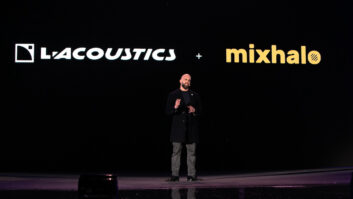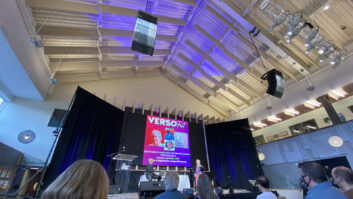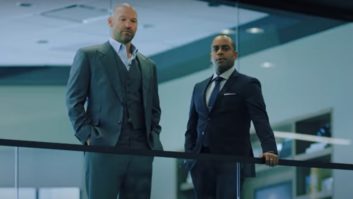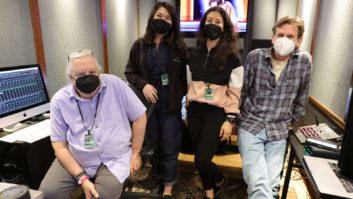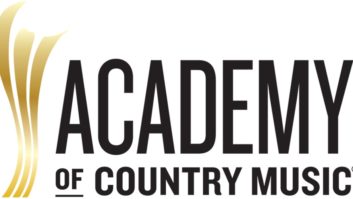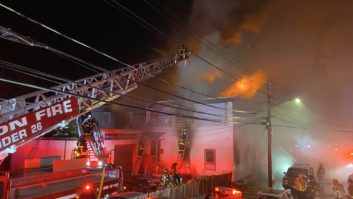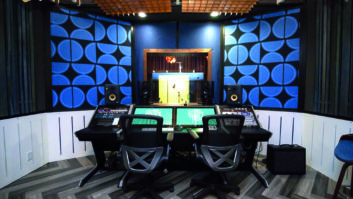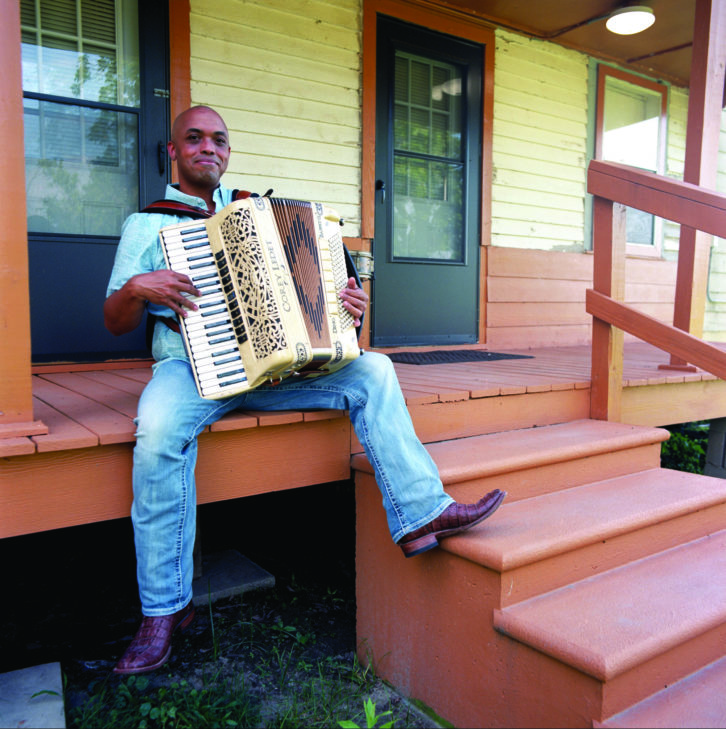
Corey Ledet received a Grammy nomination in 2013 for an album called The Best, but he hasn’t stopped working to further his sound and to promote a musical tradition that stretches back to his great grandfather, who played bass for jazz artist Bunk Johnson.
Musicianship traveled on down the Ledet line: Ledet’s grandfather was a drummer for Clifton Chenier and Rockin’ Dopsie, and many subsequent pro and semipro Ledets have contributed to Louisiana’s musical heritage.
Ledet’s latest release, Corey Ledet Zydeco, is his 14th album and his first to feature the Kouri-Vini regional dialect (Louisiana Creole) spoken by many members of his family. It takes tunes like Fats Domino’s “I’m Walking” to a new place that uniquely refreshes and sustains Ledet’s musical roots.
Corey Ledet Zydeco was recorded at Dockside Studio (Maurice, La.), a secluded residential facility set on 12 acres beside the Vermilion River. Produced by Ledet and Louis Michot, the album was engineered by Dockside Studio Manager Justin Tocket, who has been based at the facility since 2013.
“I was in Nashville for 25 years, and then I was introduced to this place about 20 years ago by Marc Broussard, who I was working with quite a bit,” Tocket says. “I just fell in love with the place and the whole idea of living where you work. Inspiration can come any time. It’s such a creative approach to making records. I started bringing a project or two here every year, and then it got to the point where I was able to make the move. It’s always appealed to me because of its history with its own genres of music—zydeco, Cajun and the blues—that comes out of this area.”
Dockside, owned by Steve and Cezanne Nails, is equipped with a 52-input Neve 8058 console and Steve Durr-designed custom soffited main monitors. Tocket says that Ledet and his band (organist Cecil Green, bass player Lee Allen Zeno, harmonica player Grant Dermody, guitarist/background vocalist Julian Primeaux and drummer Gerard Delafose) arrived well-rehearsed, but Ledet and his production team first took time to discuss ways to achieve the classic zydeco sound that Ledet wanted.
“He was looking for something that harkened back to old Buckwheat Zydeco records,” Tocket says. “There’s a thing that some zydeco bands do where the kick drum sound is very reminiscent of an ’80s heavy metal kick, with lots of point and sub but nothing in the middle. And then there’s also a very cranked-up snare sound that’s prevalent in zydeco music. But when you listen to older records, they’re much more natural-sounding.”
Delafose’s drums were set up with the player’s back to the tracking room glass. Tocket says his “get-the-attack mic” was a vintage D12, and he placed a Neumann FET 47 outside the kick. “Royer overheads are always my go-to,” he continues. “I love the way ribbons treat the top end. Zydeco music in general has a lot of midrange frequencies, so I use Coles on Corey’s accordion, to shave off some of the graininess of the instrument.”
As for other drum-related choices, Tocket uses spaces, as well as microphones, creatively. “One of my favorite things that we have at Dockside is a hallway between the control room and the tracking room,” the engineer explains. “It has all this terracotta tile on the floor. The walls are angled and they’re made of old wooden doors. It wasn’t necessarily built to be a chamber, but it’s fantastic. I put a stereo AKG C24 in there, and it instantly goes from zero to John Bonham. That’s great flexibility because the studio was built in the ‘80s, and it has a fairly controlled-sounding live room.”
Further drum mic choices include a selection of beyerdynamics: M201s on snare top and bottom, and an M88 placed above the kick drum mics. “Tchad Blake calls that one the ‘bone mic,’” Tocket says. “That actually becomes a good 80 percent of my drum sound.”
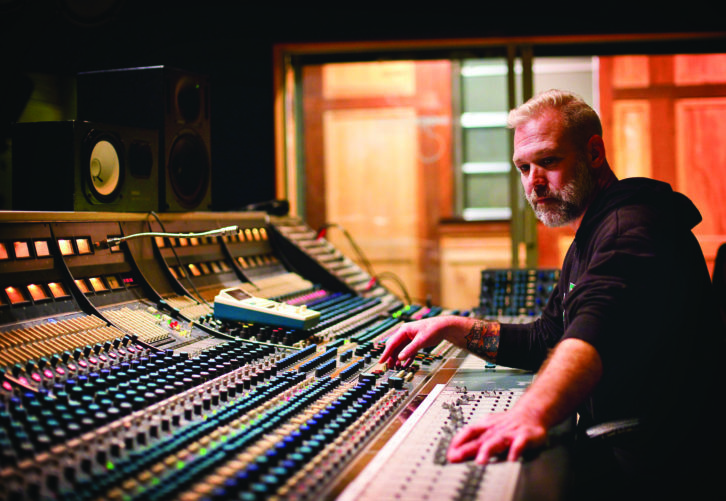
Tocket recorded almost all of the tracks live, with Ledet singing lead vocals in a booth that’s spacious enough for him to play accordion simultaneously.
“We went back later and replaced a few accordion parts, but he always played and sang at the same time,” Tocket says. “I’d place the Coles ribbon mics left and right because he was doing some left-hand bass work.” Those microphones were run through the mic pre’s in the Neve console, as well as a pair of Empirical Labs Distressors.
Tocket captured Ledet’s vocal with a Sony C37a mic. “That mic would also have been through a Neve pre, as well as these six Neve 32264 compressor/limiters built into the center section of the board; they’re amazing on vocals,” he says.
Bassist Zeno was situated in the main tracking room, in front of the drum kit, playing through the studio’s 1964 Ampeg B15 bass amp.
“The guitar player [Primeaux] was in the room with the drummer, too, but we put his [Fender Tweed Deluxe] amp in this sort of hallway where the stairwell goes up to the second-floor living quarters,” Tocket explains. “I close-miked the guitar amp with a Neumann U67. Zydeco guitar is very percussive, so that along with a very midrange-y accordion and highly tuned snares adds up to a lot of midrange information. The U67 lets me get a nice tight bottom and warm tones on the guitar.
“I also had an RCA 77 up on the first platform of the stairwell,” he continues. “It’s a big wooden staircase, and I can hang that 77 and get the most beautiful, woody room tone on the guitar. I like to play with the stereo space, too, so I had another U67 panned a bit left and then that stairwell more to the right, or sometimes we’ll use an ATR 102 half-inch machine for slapback. I used that a lot on guitar on this record, as well.”
Also on guitars, Tocket used selections from his rack of vintage API pre’s, including 550a EQ and 525 compression.
The project was tracked to Dockside’s Pro Tools HD3 system, but Tocket’s hybrid approach to mixing also incorporates the Neve. He says: “Another thing that helped get the classic sound that Corey wanted was limiting myself to strictly analog effects. We’ve got a couple of great EMT 140 plates, and an AKG PX20 spring reverb that I love on vocals, as well as the ATR 102 for tape slap. There’s yet another great hallway upstairs that I use every now and again as a chamber.
“I feel like when you take a mix out of here, the building is a big part of the sound,” he adds with a touch of pride. “It’s not a preset or a room sound I could get anywhere else. It’s something that you can only get here, and that is definitely endearing to me.”
